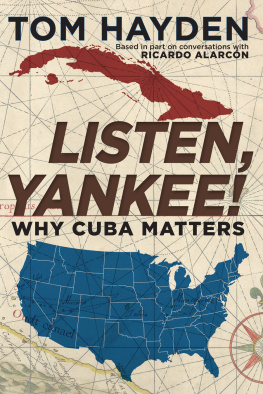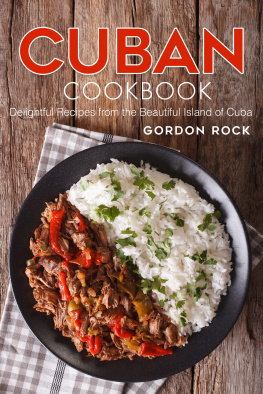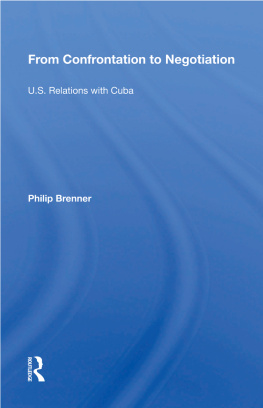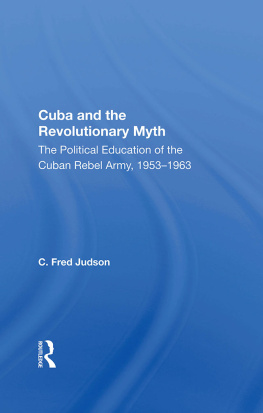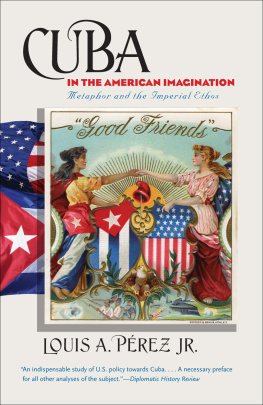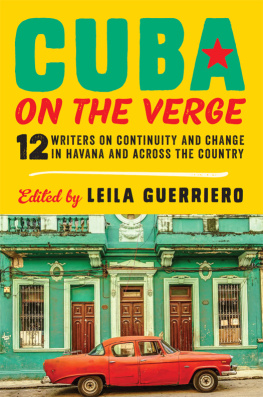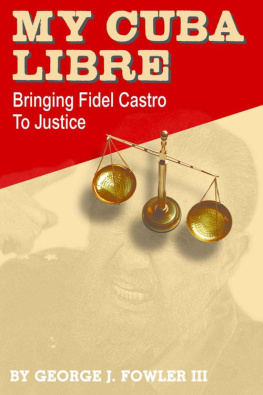
CHAPTER 1
A Heroic Creation
Bliss was it in that dawn to be alive,
But to be young was very heaven!
WILLIAM WORDSWORTH, 1805
K nowing his biography, it is hard to believe that Ricardo was predestined to be a Politburo member of the Cuban Communist Party or, more generally, that Cubas journey into Marxism-Leninism was inevitable. The islands long battle for real independence from the United States, combined with Americas Cold War version of Manifest Destiny, produced those outcomes.
Ricardo Alarcn de Quesada was born in 1937, blue eyed and blond haired, into a family he describes as the Camagey aristocracy but which also included a long line of nationalist ancestors. Fidel ran for Cubas House of Representatives, driving his American Chevrolet fifty thousand kilometers across the island before the elections were suspended when Batista seized power. Ricardo would become devoted to the 26th of July movement.
These young Cuban revolutionaries were plagued by the divisions that confront many social movements. Their ranks included nationalists, Marxists, Trotskyites, constitutionalists, torch carriers, bomb makers, clandestine couriers, and furious militants seeking revenge, united temporarily in a sea of boiling currents. Though a member of the 26th of July, Ricardo grew up with many friends in the revolutionary Directorate, or Direc- torio, a student-led movement devoted to overthrowing the dictator.
RICARDO: I was not a member of the Directorio but was close to many of its members, especially Fructuoso.
His friend Fructuoso Rodriguez was the student leader who helped lead the audacious but unsuccessful attack on Batistas presidential palace on March 13, 1957. These extraordinary instances of student-led urban uprisingsMoncada in 1953, the palace attack in 1957, and another in Santiago in 1956 meant to accompany Fidels landing in the leaking Granma vesselall in less than five yearswould mark forever the lives of those in their twenties who made the Cuban Revolution.
RICARDO: When I entered the university as a student at the School of Philosophy and Letters, I got involved in the student struggles around two main issues: the role of the student movement in opposition to Batista, especially the decisive question of armed struggle versus the peaceful mass struggle advocated by the Communists, and the university reform movement to improve the quality of education and cleaning up the corrupt politicking... I got involved with the activities of a group of women who were working on the second point, the moral recovery of the student association.
University reform, one of the central strands leading to the Cuban Revolution, arose in Argentina at the time of the Russian and Mexican revolutions under the intellectual and idealistic leadership of Jos Ingenieros, whose writings condemned the alleged mediocre man formed by capitalismakin to the man in a gray flannel suit in American fifties cultural criticismand extolled the moral man with a new revolutionary ethos. The university reform project suggested a central role for young students and intellectuals if they would commit to rebel on behalf of moral incentives, a precursor, perhaps, to Ernesto Che Guevaras later call for a new man.
Deep corruption and compromise characterized Havana at the time, reflecting the establishment of a de facto Mafia empire operated from the United States.
The ethos of gangsterism infected the campuses. Ricardos generation witnessed seizures of power, dictatorship, the zoning of their island for US-based Mafia rule, and the absorption of the Left and its trade unions into the ruling regime, leaving many young radicals feeling there was nowhere to turn. Gen. Fulgencio Batista had led a September 1933 coup against the weak provisional government of Carlos Manuel de Cespedes y Quesada who had come to power less than a month before, replacing the dictator Gerardo Machado. Batista then took control of Cubas military, manipulated presidential elections from behind the scenes, was elected as an authoritarian president himself in 1940, and ushered in just enough reform, especially labor legislation, to attract the support of the Cuban Communist Party (the Popular Socialist Party, or PSP). The party sought shelter against anticommunist repression, and Communist-affiliated unions benefited from concessions to their workers. During the thirties and forties, the party adopted a Popular Front policy of collaborating with conservative governments like Cubas in the interest of building Western support for the Soviet Union against Nazi aggression. By 1952, on the eve of Moncada, what Ricardo calls the peaceful mass struggle advocated by the Communists had stagnated into an understanding between the Cuban CP and the Batista dictatorship, while at the same time Havana was being transformed into a garish sanctuary for casinos, brothels, drugs, and money laundering on behalf of the North American Cosa Nostra. According to Robert Scheer and Maurice Zeitlins 1963 study, the Cuban [Communist] Party had been the first to place a member in the national cabinet, first to learn how to survive under a dictatorship, and first to achieve power in the labor movement and politics.
Given their politics and alliances, the Cuban CP condemned the rebel storming of Moncada as reckless adventurism and frowned as well on conspiracies to storm the presidential palace.
Of some 160 Cubans involved in the Moncada attack, eighty were captured in three days.
The understanding between the CP and Batista was a contradiction, Fidel said later, which caused many of the young people with revolutionary inclinations as well as people on the Left to stop sympathizing with the Cuban Marxist-Leninist Party.
This insurrectionary tradition was embodied in the life of Julio Antonio Mella, a founder of the Cuban Communist Party who was exiled to Mexico where, like Fidel a generation later, he planned an invasion by sea. Mella was killed after taking two bullets to the back on January 10, 1929, using his final moments to accuse Machado of ordering his assassination. Influencing Mella was a Peruvian thinker, Jos Carlos Maritegui (18941930), who adapted to Peru the Marxist ideas he absorbed during an Italian exile. Mariteguis greatest relevance may lie in his early insistence on a Communist Party of Peru independent of the dictates of the Communist Internationals Soviet-centered leadership. Thus he helped originate the Latin Americanization of inherited European-centered Marxism. Both revolutionaries would be deep influences on Ricardo and his generation.
RICARDO: In every meeting of our movement, for previous generations as well, nobody ever denied that Mella was our president. He was the greatest member of our generation. Even people fighting the Communists thought so. Not long ago, Cuba published some work on Mella. He had been a most outstanding defender of the Russian Revolution in those days. But later he said he didnt want to have in Cuba what Lenin did in Russia. It was one thing to follow a revolution in a different country with a different history, but it went beyond that. Mella said, We want people who think with their own brains, not the brains of others. We dont want what he called conducted brains. That spirit disappeared. I discovered the article by Mella many years later. It was never in any Communist Party newspapers. This was by a young leader of a party that was supposed to follow a Soviet line!
Maritegui was a Peruvian theorist who was another big Bolshevik supporter but who advocated a different, original kind of socialism, one that cannot be copied. Heroic creation, he called the process. Creation meant it had to be original, or originated through an act. Heroic meant it would come into shape through struggle.
Next page
